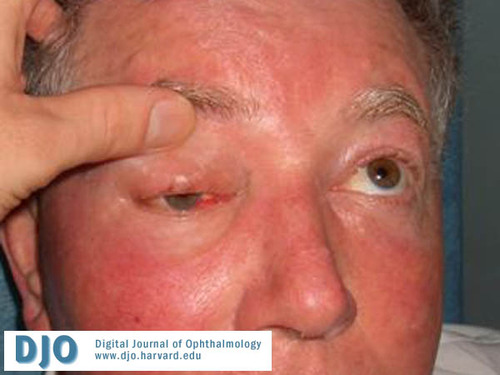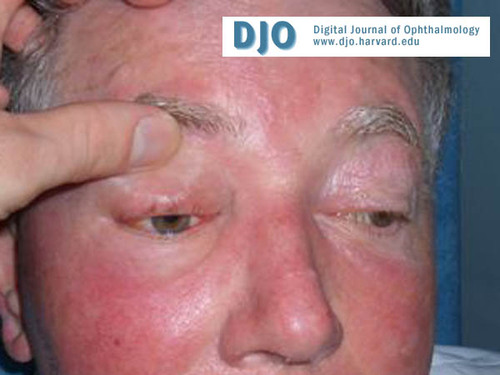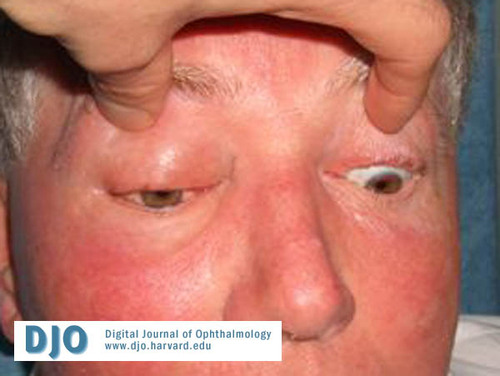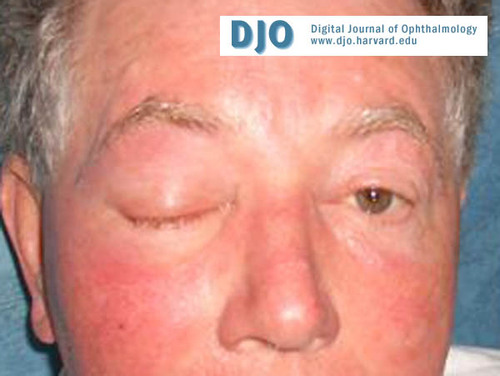A 73-year-old man with acute orbital swelling following cataract surgery
Digital Journal of Ophthalmology 2007
Volume 13, Number 8
August 28, 2007
Volume 13, Number 8
August 28, 2007
His past ocular history was notable for an uncomplicated cataract extraction with placement of an intraocular lens in the left eye 6 months prior. He had no significant past medical history.

Figure 1
Attempted upgaze showing limited elevation of the right eye
Attempted upgaze showing limited elevation of the right eye

Figure 2
Attempted leftgaze showing limited adduction of the right eye
Attempted leftgaze showing limited adduction of the right eye

Figure 3
Attempted downgaze showing limited depression of the right eye
Attempted downgaze showing limited depression of the right eye

Figure 4
Lid swelling and ptosis
Lid swelling and ptosis
Computed Tomography of orbits showed diffuse edema of orbital tissues but no evidence of retrobulbar hemorrhage and no focal lesion.
Allergen Testing
Cutaneous allergen patch testing showed hypersensitivity to hyalouronidase.
Retrobulbar haemorrhage is a well recognized but rare complication of cataract surgery. The incidence is estimated at between 0.44% and 1.7% with retrobulbar local anesthetic blocks,(1, 2, 3) but is lower with Sub-Tenon's anesthesia.(5) It can present with acute proptosis, periocular ecchymosis, restricted eye movements and loss of vision. However in this case computed tomography scanning of orbits showed diffuse orbital edema but no evidence of hemorrhage.
2. Orbital cellulitis
Orbital cellulitis is another rare complication of cataract surgery and can present with lid swelling, proptosis and restricted eye movement.(6) However it would also be expected to be associated with headache, pyrexia and systemic upset.
3. Hypersensitivity reaction
Cutaneous allergen patch testing in this case demonstrated hypersensitivity to hyaluronidase. Of note hyaluronidase had been added to the local anesthetic mix for the affected right eye but had been omitted when the fellow left eye had been operated upon uneventfully 6 months previously.
4. Endophthalmitis
Acute endophthalmitis following cataract surgery may also present with lid swelling but in the absence of any intraocular inflammation or reduction in vision this diagnosis can be excluded.
5. Nerve palsy and/or extraocular muscle injury
Periocular anesthesia may be associated with nerve palsies leading to impaired ocular motility. In particular the oculomotor nerve is often affected by periocular anesthesia. However this effect is short-lived and not associated with the proptosis and periocular swelling seen in this case. Direct injury to extraocular muscles may also impair ocular motility but would be associated with restriction of movement in the direction of action of the affected muscle, and would again not be associated with the proptosis, periocular swelling and diffuse edema seen in this case.
The presentation in this case was similar to that described in a previous case series of hypersensitivity reactions to hyaluronidase following peribulbar anaesthetic for cataract surgery.(7) The typical presenting features in this case series were proptosis, peribulbar erythema and itching, restriction of extraocular muscle function, conjunctival chemosis, pain and itch. The management in this case involved observation and oral anti-histamines. Complete resolution occurred over the following 7 days.
2. Ruben S. The incidence of complications associated with retrobulbar injection of anaesthetic for ophthalmic surgery. Acta Ophthalmologica 1992; 70: 836-8
3. Cionni RJ, Osler RH. Retrobulbar haemorrhage. Ophthalmology 1991; 98: 1153-5
4. Rahman I. Ataullah S. Retrobulbar hemorrhage after sub-Tenon's anesthesia. Journal of Cataract & Refractive Surgery 2004; 30(12):2636-7
5. Konstantatos. Anticoagulation and cataract surgery: a review of the current literature. Anaesthesia & Intensive Care 2001; 29(1): 11-8
6. Hofbauer JD, Gordon LK, Palmer J. Acute orbital cellulitis after peribulbar injection. American Journal of Ophthalmology 1994; 118(3): 391-2.
7. Leibovitch I, Tamblyn D, Casson R and Selva D. Allergic reaction to hyaluronidase: a rare cause of orbital inflammation after cataract surgery. Graefe's Archive for Clinical and Experimental Ophthalmology 2006; 244(8): 944-949